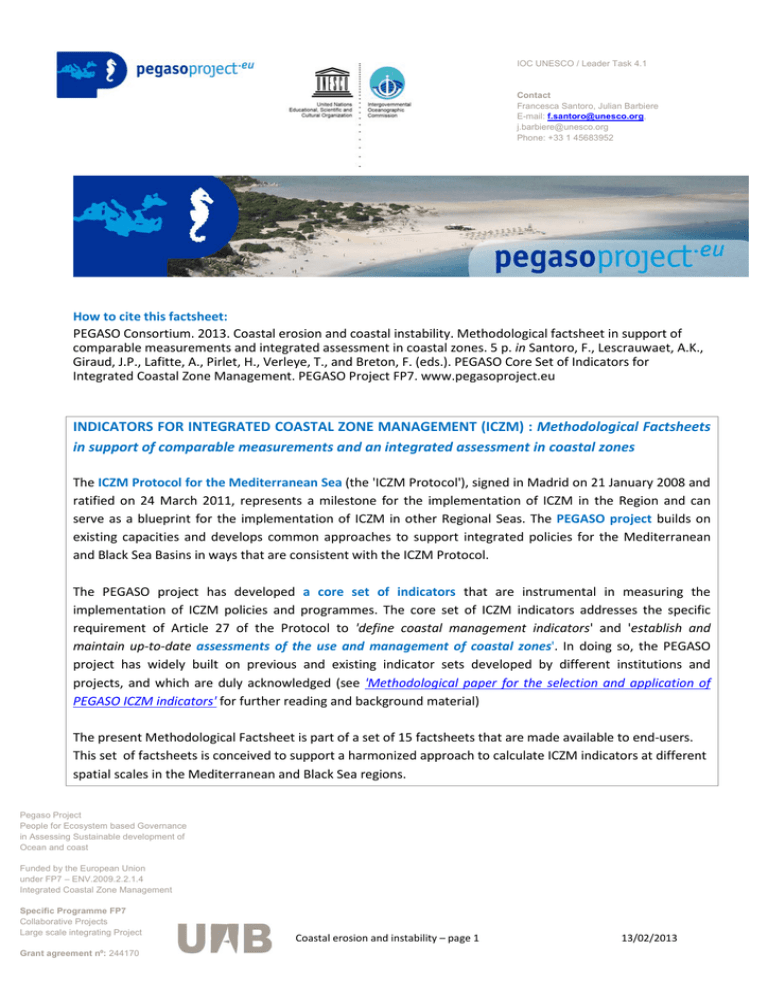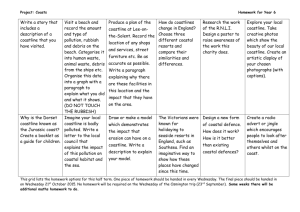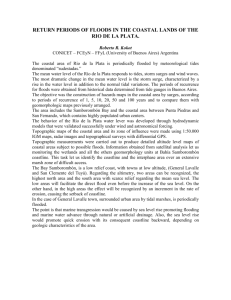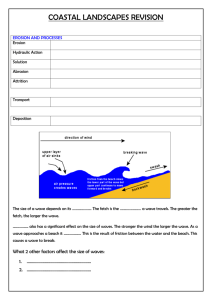Document 12460534
advertisement

IOC UNESCO / Leader Task 4.1 Contact Francesca Santoro, Julian Barbiere E-mail: f.santoro@unesco.org, j.barbiere@unesco.org Phone: +33 1 45683952 How to cite this factsheet: PEGASO Consortium. 2013. Coastal erosion and coastal instability. Methodological factsheet in support of comparable measurements and integrated assessment in coastal zones. 5 p. in Santoro, F., Lescrauwaet, A.K., Giraud, J.P., Lafitte, A., Pirlet, H., Verleye, T., and Breton, F. (eds.). PEGASO Core Set of Indicators for Integrated Coastal Zone Management. PEGASO Project FP7. www.pegasoproject.eu INDICATORS FOR INTEGRATED COASTAL ZONE MANAGEMENT (ICZM) : Methodological Factsheets in support of comparable measurements and an integrated assessment in coastal zones The ICZM Protocol for the Mediterranean Sea (the 'ICZM Protocol'), signed in Madrid on 21 January 2008 and ratified on 24 March 2011, represents a milestone for the implementation of ICZM in the Region and can serve as a blueprint for the implementation of ICZM in other Regional Seas. The PEGASO project builds on existing capacities and develops common approaches to support integrated policies for the Mediterranean and Black Sea Basins in ways that are consistent with the ICZM Protocol. The PEGASO project has developed a core set of indicators that are instrumental in measuring the implementation of ICZM policies and programmes. The core set of ICZM indicators addresses the specific requirement of Article 27 of the Protocol to 'define coastal management indicators' and 'establish and maintain up-to-date assessments of the use and management of coastal zones'. In doing so, the PEGASO project has widely built on previous and existing indicator sets developed by different institutions and projects, and which are duly acknowledged (see 'Methodological paper for the selection and application of PEGASO ICZM indicators' for further reading and background material) The present Methodological Factsheet is part of a set of 15 factsheets that are made available to end-users. This set of factsheets is conceived to support a harmonized approach to calculate ICZM indicators at different spatial scales in the Mediterranean and Black Sea regions. Pegaso Project People for Ecosystem based Governance in Assessing Sustainable development of Ocean and coast Funded by the European Union under FP7 – ENV.2009.2.2.1.4 Integrated Coastal Zone Management Specific Programme FP7 Collaborative Projects Large scale integrating Project Grant agreement nº: 244170 Coastal erosion and instability – page 1 13/02/2013 Name of the Indicator Areal extent of coastal erosion and coastal instability. Objective of the indicator Erosion and accretion are naturally occurring phenomena that exist in a dynamic equilibrium, in absence of human disturbance. However, coastal artificialisation (the construction of dikes, harbours and protective structures) has accelerated the erosion processes in many coastal areas while it has caused the accretion and the shoaling of sand in many others, changing the dynamic equilibrium of coastlines and coastal areas of European countries. Erosion is perceived as a problem when it threatens human interests (built environment, economic assets, protected areas). The present indicator gives an insight in the dynamic state of the coast and provides information on the extent to which coastal urban settlements and ecosystems are threatened by the eroding trend in some regions. Long- term series of this measurement, in combination with data on the artificialisation of the coast, may shed a light on the impact of construction works on the mass-energy balance of the natural beach systems. Policy context ICZM Policy Objective ICZM Protocol Article To prevent damage to coastal environment, and appropriate restoration if damage already occurred Article 23: Coastal erosion UNEP-MAP Ecological Objective INSPIRE ANNEX I-III Data Theme (34) Objective 8: The natural dynamics of coastal areas are maintained and coastal ecosystems and landscapes are preserved Operational objective 8.1: The natural dynamic nature of coastlines is respected and coastal areas are in good condition Natural risk zones (Annex III – 12) Oceanographic geographical features (Annex III – 15) Coverage CALCULATION OF THE INDICATOR Spatial consideration Resolution-Reporting unit(s) The coastlines of the Mediterranean Sea and the Black Sea Period Different relevant reporting units may apply, according to the coastal management system in place. These reporting units can be ‘management units’ or ‘sediment cells’ (see below). In absence of these units for management and/or reporting purposes, the data can be spatially reported by NUTS 3 or lower. Temporal consideration Resolution (time interval or unit) At least two measurements with 5 years of difference E.g. Annual or every 5 years (at fixed reference intervals) (T1 and T2) are needed to compare the position of the baseline (T0). (i) Parameter(s) Percent of shoreline in erosion or accretion, or stable Coastal erosion and instability – page 2 13/02/2013 Calculation method (based on DEDUCE factsheet) Steps Products 1. Delimit the extent of your reference region (municipality, county, province or region) and identify the relevant reporting unit(s) within this region. Specified reference area and relevant reporting units within, based on socio-political boundaries or natural coastal processes/land use. A sediment cell is defined as a length of coastline, which is essentially self-contained as far as the movement of sand and other sediments is concerned such that the interruption to such movement in one cell should not have a significant effect on adjacent sediment cells. The boundaries of the sediment cells generally coincide with large estuaries or prominent headlands and not sociopolitical boundaries. In order to develop detailed sustainable coastal defence and shoreline management options within the Plan area, operation authorities generally divide the primary cells or sub-cells into Management Units. A management unit is a length of shoreline with coherent characteristics in terms both of natural coastal processes and land use. 2. Choose an adequate base map (for the baseline Total coastline length with reference to scale of measurement of T0 (1990 or near) with the appropriate measurement 1 reference scale. Select all the coastline segments and join them in order to obtain the summation of the total 2 coastline length using GIS statistical tool . An appropriate reference scale would be a 1:10.000 scale map, but scales of up to 1:50.000 can be used if the first is not available. 3. Classify coastline segments into stable, eroded or Location and extent (length) of dynamic coastline, accreted compared to the baseline measurement T0. classified as eroded or as accreted shoreline. Within the GIS tool, this selection is based on an evolutionary trend, superimposing the previous baseline measurement, defining layers of coastline segments that 3 are considered dynamic and classifying them into coast in erosion and coast in accretion. The accreted coastline should be visualized in green, the eroded coastline in red, whereas a stable coastline should be indicated in blue (reference color scale to be defined by SDI). 1 The term “coastal segment” is used because it greatly depends on the coastline calculation method used and size may vary in accordance with techniques. 2 In measuring the length of the coastline, the perimeter of harbours and other shelter constructions (such as marinas) is not considered. Very important is that, the sum of dynamic coastline length plus stable coastline length, must be the total coastline length. Segments where data is not available can be labelled as “no data” 3 A segment is considered stable if evolution is almost not perceptible at human scale and generally stable if small “occasional” variations around a stable position occur (evolutionary trend is uncertain). Coastal erosion and instability – page 3 13/02/2013 4. Add up the coastline lengths of eroded shoreline (1) and A number that estimates the sum of the length of the coastline length of accreted shoreline (2) dynamic coastline, either classified as eroded (1) or as accreted (2) coastline length 5. Divide the product of step 4 by the product of step 2 and Proportion of eroded (1) and accreted (2) length of multiply it by 100. coastline, and proportion of stable coastline as a percentage of the total coastline length, compared to baseline measurement T0. Length of dynamic coastline 100 90 % coastline length 80 70 % Stable 60 % Eroded 50 % Accreted 40 30 20 10 0 1995 2005 Year 6. Repeat steps 3 to 5 for the subsequent measurements T1 and T2 (,…) compared to T0, and obtain the same products as step 3 and 5 for these measurements. Location and extent of dynamic coastline, classified as eroded or as accreted shoreline, compared to the baseline measurement T0. Proportion of the eroded and accreted coastline, as a percentage of the total coastline length, compared to the baseline measurement T0. Current monitoring Data sources Coastal erosion and instability – page 4 13/02/2013 N/A National mapping agency/sources. Administrations responsible for the environment or coastal management. Coastal Erosion Layer CEEUBG100KV2 and the Evolution Trends attribute (CEEVV2) from the EUROSION Project. Assessment context Use of the indicator in DEDUCE previous assessments/initiatives State – Impact DPSIR framework Link to anthropogenic Construction of infrastructure (protective structures, harbours) pressure Sustainability target or threshold Link with the following descriptors of the marine strategy framework directive: Link with other assessment tools Example of integrated assessment (6) Sea-floor integrity is at a level that ensures that the structure and functions of the ecosystems are safeguarded and benthic ecosystems, in particular, are not adversely affected. (7) Permanent alteration of hydrographical conditions does not adversely affect marine ecosystems. Scope for future improvements While the quality of erosion rate data is very high due to on-site visits, aerial photography, and remote sensing, the cause and effect relationship of erosion may be less clearly defined. Erosion rates are indicative for the effect of many different processes. Care must be taken to consider the influence of single severe storm events on erosion rates. Annual analysis may not be as insightful as studies of longer time periods. Although the cause-effect relationship of sedimentological processes is not always clear, mathematical modelling techniques may help to assign certain erosion or aggradation trends to anthropogenic activities and thus differentiate between man-induced and natural sedimentation patterns. To add value to the indicator the results of the current indicator could be combined with a coastal classification layer such as rocky coast, sandy beach, cliffs, estuaries, etc. as these features respond and are affected by erosion in a very different manner. Data Harmonization In order to build a common, regional view for a particular indicator, it is crucial to harmonize the data in terms of e.g. concepts, definitions, reporting units, colour codes, value class boundaries and scoring methods. For this purpose, the PEGASO consortium has developed ‘Guidelines for Data Harmonization’ which are available from the ‘Products’ section on the PEGASO project website www.pegasoproject.eu. Although agreements may exist related to the presentation of certain indicators that are legally embedded, this may be less evident for indicators which are not (yet) used as an instrument within a policy context or within a region where the policy is not applicable. The PEGASO consortium encourages contributing partners, stakeholders and end-users to consult the ‘Guidelines for Data Harmonization’ document, and to actively engage in this process. Indicator references (i.e. UNEP, EEA, …) EEA - coastal erosion patterns in Europe EEA - Percentage of artificial coastline length Eurosion – Coastal erosion indicators study Coastal erosion and instability – page 5 13/02/2013







